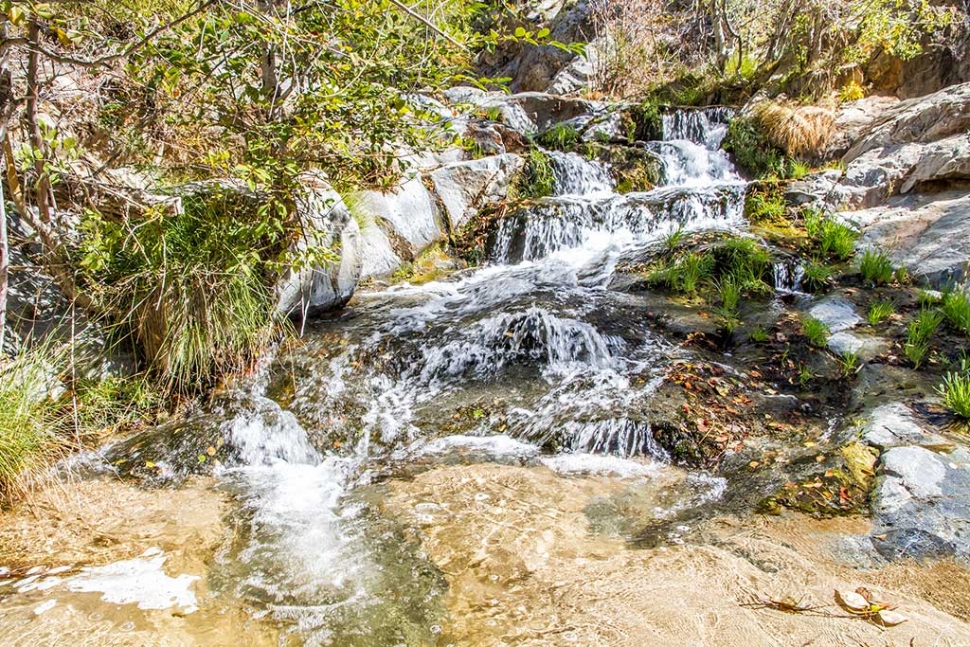|
Photography Know-How
 Photo of the Week by Bob Crum. Brush Creek Falls, North of Kernville, Ca. Data: ISO 100, 18mm, f/19 @ 1/ 8 seconds. By Bob Crum — Wednesday, May 10th, 2017
259 Q & As
 So many questions I'm exhausted at the outset! Worse, the 5-Hour Energy Boost lasted only five minutes. I get more energy from cantaloupe. Nevertheless, onward! First question: “Why do you list the Photo of the week photo data?” A mermaid's suggestion. Remember the Digital Pixel Psalm ISO 200:f/11.1/60 I presented a few weeks ago? To refresh: “There shall be three Wise Elements in the Mighty Trinity of Exposure; Aperture, Shutter Speed and the Holy ISO.” Understanding the psalm will help you get perfectly exposed photographs. More importantly, once you understand the relationships you can begin to exert 'creative artistic license' to your photography. That's when photography gets very interesting. For example, Brush Creek falls north of Kernville. I can photograph the falls to show the flow realistically or add a creative touch by giving the water a more silky look. If I choose blur for the silky effect, I need to increase the exposure time by slowing down the shutter speed. However, reducing the shutter speed too much will result in an over exposed image. Lowering the ISO which decreases the camera sensor sensitivity is one way I can compensate. What if I'm at the lowest ISO setting? Then I close the aperture a few “f” stops to decrease the amount of light entering the lens. If neither work, I either throw a temper tantrum or throw the camera at the falls. Both are refreshingly therapeutic. Look at the photo of the week (if not here, online at fillmoregazette.com) Notice that I chose a creative touch... a blur effect to the water fall. The data is ISO 100, 18mm (wide angle) f/19 @1/8 sec. 100 is my camera's lowest ISO value. At a slow 1/8 sec shutter speed I had to stop the lens down to f/19 to prevent an overexposure. This illustrates the ISO/Shutter/Aperture relationship. I could have attached a 'neutral density filter' (subject for another time) but chose not to. The realistic waterfall photo data is ISO 320, 18mm, f/11 @1/60 sec. The 1/60 speed portrays a more realistic water flow but I have to open the aperture to f/11 to prevent underexposure. I selected f/11 to maintain the depth-of-field (DOF) and further compensated for underexposure by increasing the ISO to 320. It's all about the Mighty Trinity of Exposure. Caution: In addition to blur, real slow shutter speeds and shaky hands most often create fuzzy photos. Hence the need for a monopod or tripod. Actually, after a couple of strawberry margarrrritas, my blurry and fuzzy photos look like some of my most creative work! Understanding the digital pixel psalm enables you to program the camera to obtain exactly the kind of photo that you mentally envision. Practice!!! Practice!!! Practice!!! Now you understand that you can interpret my photographic decisions by the photo data. For example, an f/4 aperture (wide open) indicates intentional background blur (bokeh). An f/ll or smaller will indicate that I intended maximum DOF. Slow shutter speeds to indicate movement. Fast shutter speeds to freeze the motion. Decisions, decisions, but unlimited variable options present exhilarating opportunities. The ability to “create” a photograph as desired by programming the camera is an extremely fulfilling aspect of photography. And you wonder why I'm so fanatical? Sorry folks but no space left for the other 258 questions! Happy photoing! Email comments, questions or suggestions to bob@fillmoregazette.com |
